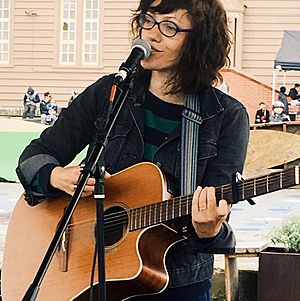Kindie rock facts for kids

Kindie rock is a fun type of music made for kids. It combines the style of a singer-songwriter with themes that children under 10 can enjoy. Many famous kindie rock artists, like Dan Zanes and They Might Be Giants, were already popular adult musicians. The name "kindie rock" was first used in 2006 by writer Scott Lamb.
Even though it has "rock" in its name, kindie music isn't just rock. It includes many different music styles. Lately, people often just say "kindie music" or "kindie." The word "kindie" comes from combining "Kid" and "Independent." This means kindie artists are free to create music from their hearts. They don't have to follow strict commercial rules. Kindie artists want to make music for kids with the same care and thought as music for adults. It's often seen as different from mainstream children's music. A strong community is also a big part of the kindie scene today. Events like the Kindiecomm conference and the Hootenanny gathering show this.
Contents
What is Kindie Music?
Kindie music is special because it focuses on creativity and independence. Unlike some commercial children's music, kindie artists often write their own songs. They explore many different sounds and topics. This makes the music interesting for both kids and their parents. The main goal is to create high-quality music that kids will love.
Music Styles in Kindie
While "kindie rock" might make you think of only rock music, kindie artists actually play many different styles. Sometimes, one album can even have several types of music! Kindie musicians use many rock styles, including roots rock, indie rock, metal, psychedelic rock, pop music, prog-rock, and punk.
They also play other kinds of music. These include electronica, experimental music, folk, hip hop, jazz, reggae, and soul. This wide variety means there's a kindie song for almost everyone!
Kindie Community and Groups
The kindie music world is very community-focused. Artists often work together on songs and projects. There are also important groups and events that help this community grow.
Kindiecomm Conference
Kindiecomm is a major meeting for kindie musicians. It started in 2013 and now happens every two years. Kathy O'Connell and Robert Drake from WXPN's Kids Corner radio show created it. Their goal was to bring together the "musical family" of kindie artists. They wanted to share helpful information in a friendly setting.
Children's Music Network
The Children's Music Network (CMN) was founded in 1987. It existed even before the modern kindie movement. CMN helps support and promote children's music. Many of the ways CMN supported artists continue today in the kindie world.
Other International Groups
While "kindie" is mostly known in the United States, other countries have similar groups. For example, New Zealand has the Kiwi Kids Music association. In Latin America, there's a meeting called Movimiento Canción Infantil Latinoamericana y Caribeña. This event brings together children's music artists from all over Latin America.
Kindie Music in Media
Kindie music gets a lot of support from different types of media.
Blogs for Kindie Music
Many blogs review and discuss kindie music. One of the most well-known is Zooglobble, which started in 2002. These blogs help people discover new kindie artists and songs.
Radio Shows and Podcasts
There are many radio shows and podcasts that play kindie music.
- Kids Corner on WXPN in Philadelphia has been on air since 1988. It even won a Peabody Award.
- Spare the Rock on KUTX started in 2005 and is played across the country.
- The OWTK Kid's Music Monthly Podcast has been around since 2012.
Most kindie radio shows play a mix of music. Some, like Kids Corner, also have educational segments. Many kindie shows are on public or community radio stations. Examples include "Radio Active Kids" on Asheville FM and "The Children's Hour" on KUNM-FM. "The Children's Hour" is played on many public radio stations and streamed globally.
Sirius XM's Kids Place Live in the U.S. and Canada also features kindie artists. They play popular kindie songs and have special programs. Some of these programs are even hosted by top kindie artists. There are also online stations like "WEE Nation Radio." This station plays kindie music with a global view. It includes family-friendly jazz, reggae, R&B, and world music. "WEE Nation Radio" also has a podcast and a weekly show on WPFW in Washington D.C.
Another popular podcast is "Ear Snacks," created by kindie artists Andrew & Polly. They make "Roadtrip Mixtape" selections of top kindie songs. They also do an annual tribute to Grammy nominees for Best Children's Album. This includes interviews with the nominated artists.
Kindie Music Around the World
While many bands called "kindie" are from North America, similar music exists globally. If you look for non-anonymous musicians who create complex music for kids, you'll find many artists worldwide. Most international kids' musicians use European-influenced styles. However, many artists from Latin America also include local music styles.
Kindie Music in Latin America
Latin America has many different children's music scenes. These include countries like Argentina, Brazil, Chile, Colombia, Ecuador, and Mexico. A unique feature of Latin American kindie music is that concerts are often like musical theater shows. This is different from artists in the United States or Europe.
Kindie Music in Oceania
Australia has a popular and well-known kindie scene. While it might not have as many artists as some other countries, their music is very popular. New Zealand also has many artists who are gaining international recognition.

